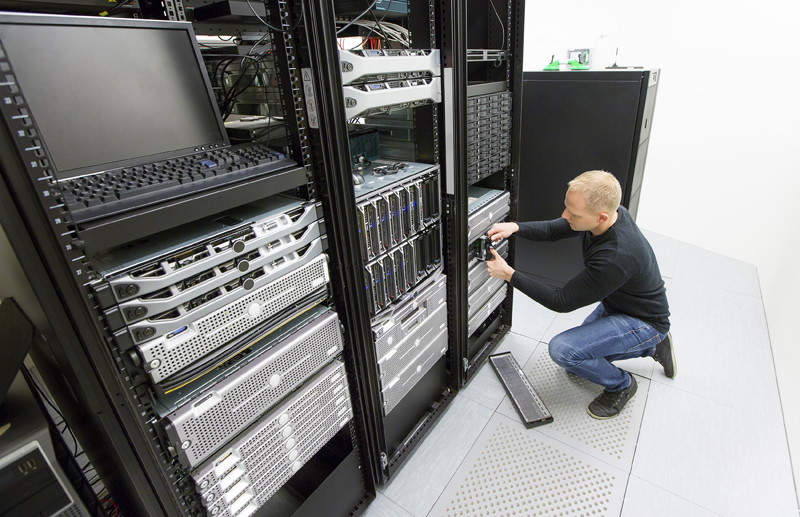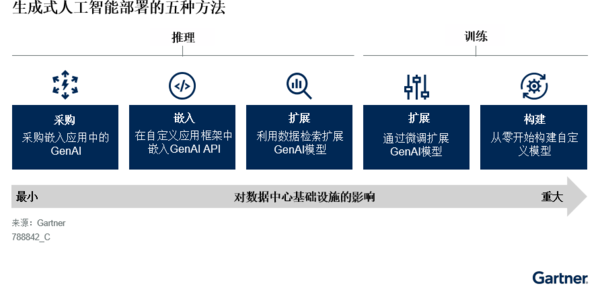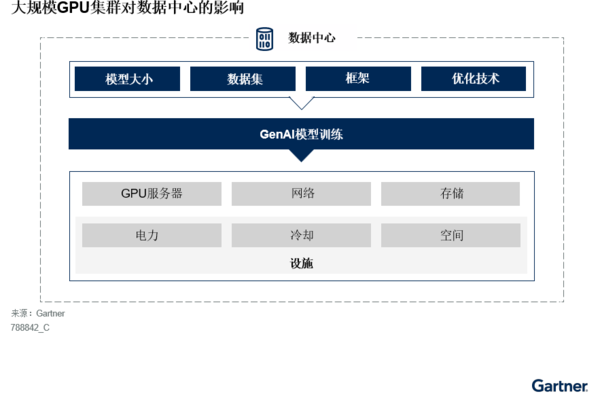 Technology peripherals
Technology peripherals
 AI
AI
 Gartner: Generative AI will drive the transformation of Chinese enterprise data center design
Gartner: Generative AI will drive the transformation of Chinese enterprise data center design
Gartner: Generative AI will drive the transformation of Chinese enterprise data center design

According to news on April 15, 2024, a 2024 CIO and technology executive survey recently released by Gartner showed that more than 60% of Chinese companies plan to Deploy generative artificial intelligence (GenAI) within 24 months. Since Chinese companies tend to deploy GenAI locally rather than through the public cloud, the current infrastructure environment cannot support GenAI projects. This will promote the design transformation of Chinese enterprise data centers.
Zhang Lukeng, research director at Gartner, said: “Due to security and data privacy concerns and regulatory requirements, some enterprises prefer to deploy GenAl solutions or fine-tune large language models (LLM) on-premises. Deploying on-premises GenAl is not just a simple hosting requirement for data centers, but may change the strategy of enterprise data centers because model training requires large-scale GPU clusters."
Gartner defines five types of GenAI deployments. method (see Figure 1). Depending on the GenAI deployment method chosen by the enterprise, China's chief information officers (CIOs) and infrastructure and operations (I&O) leaders need to understand the impact of GenAI deployment and how to take action.
Figure 1: Five methods for generative artificial intelligence deployment
 Gartner: Generative AI will drive Chinese enterprise data centers Design Transformation
Gartner: Generative AI will drive Chinese enterprise data centers Design Transformation
China’s CIOs and I&O leaders must prepare for the impact of this technology on the data center.
Deploying GenAI on-premises will force I&O leaders to change how they design hosting environments
The impact of deploying GenAI on the data center determines the types of workloads run, as some GenAI workloads require High-end graphics processing unit (GPU). Due to the limited supply of high-end GPUs in the Chinese market, I&O leaders who want to deploy GenAI on-premises will need to change the way their hosting environments are designed.
I&O leaders cannot solve supply shortages alone and must work with the business, AI engineers, and functional teams to address this challenge.
Zhang Yingling said: “Chinese CIOs and I&O leaders who prepare infrastructure resources for GenAl deployment should proactively work with business and related teams to predict the impact of different workloads on data center costs and schedules. , to develop a data center macro strategy for GenAl deployment. If training models require high-end GPU clusters, you need to fully understand various hosting options by balancing costs, risks, and opportunities (such as purchasing alternative hardware or leasing GPU resources).”
Deploying large-scale GPU clusters requires transforming and upgrading data center infrastructure and equipment
Building a basic model from scratch or fine-tuning a model requires deploying large-scale GPU clusters, which will bring consequences to existing data centers subversion. Because the training of GenAI models requires high throughput, low latency, and lossless infrastructure. To support such high-performance computing clusters, network, storage, power supply, and cooling systems must be upgraded. In some cases, existing facilities will need to be retrofitted to host the upgraded infrastructure (see Figure 2).
Figure 2: The impact of large-scale GPU clusters on data centers
 Gartner: Generative AI will drive Chinese enterprise data centers Design Transformation
Gartner: Generative AI will drive Chinese enterprise data centers Design Transformation
Zhang Yingling said: "China's CIO and I&O leaders need to work with data scientists and engineers to clarify the GPU cluster size and GenAI performance requirements to determine infrastructure such as network and storage. Requirements. At the same time, it is also necessary to analyze power requirements, cooling efficiency, racks, space, etc., to determine the gaps in the existing data center environment in deploying large GPU clusters, and to select the most suitable data center transformation solution.
The above is the detailed content of Gartner: Generative AI will drive the transformation of Chinese enterprise data center design. For more information, please follow other related articles on the PHP Chinese website!

Hot AI Tools

Undresser.AI Undress
AI-powered app for creating realistic nude photos

AI Clothes Remover
Online AI tool for removing clothes from photos.

Undress AI Tool
Undress images for free

Clothoff.io
AI clothes remover

Video Face Swap
Swap faces in any video effortlessly with our completely free AI face swap tool!

Hot Article

Hot Tools

Notepad++7.3.1
Easy-to-use and free code editor

SublimeText3 Chinese version
Chinese version, very easy to use

Zend Studio 13.0.1
Powerful PHP integrated development environment

Dreamweaver CS6
Visual web development tools

SublimeText3 Mac version
God-level code editing software (SublimeText3)

Hot Topics
 1389
1389
 52
52
 Bytedance Cutting launches SVIP super membership: 499 yuan for continuous annual subscription, providing a variety of AI functions
Jun 28, 2024 am 03:51 AM
Bytedance Cutting launches SVIP super membership: 499 yuan for continuous annual subscription, providing a variety of AI functions
Jun 28, 2024 am 03:51 AM
This site reported on June 27 that Jianying is a video editing software developed by FaceMeng Technology, a subsidiary of ByteDance. It relies on the Douyin platform and basically produces short video content for users of the platform. It is compatible with iOS, Android, and Windows. , MacOS and other operating systems. Jianying officially announced the upgrade of its membership system and launched a new SVIP, which includes a variety of AI black technologies, such as intelligent translation, intelligent highlighting, intelligent packaging, digital human synthesis, etc. In terms of price, the monthly fee for clipping SVIP is 79 yuan, the annual fee is 599 yuan (note on this site: equivalent to 49.9 yuan per month), the continuous monthly subscription is 59 yuan per month, and the continuous annual subscription is 499 yuan per year (equivalent to 41.6 yuan per month) . In addition, the cut official also stated that in order to improve the user experience, those who have subscribed to the original VIP
 Context-augmented AI coding assistant using Rag and Sem-Rag
Jun 10, 2024 am 11:08 AM
Context-augmented AI coding assistant using Rag and Sem-Rag
Jun 10, 2024 am 11:08 AM
Improve developer productivity, efficiency, and accuracy by incorporating retrieval-enhanced generation and semantic memory into AI coding assistants. Translated from EnhancingAICodingAssistantswithContextUsingRAGandSEM-RAG, author JanakiramMSV. While basic AI programming assistants are naturally helpful, they often fail to provide the most relevant and correct code suggestions because they rely on a general understanding of the software language and the most common patterns of writing software. The code generated by these coding assistants is suitable for solving the problems they are responsible for solving, but often does not conform to the coding standards, conventions and styles of the individual teams. This often results in suggestions that need to be modified or refined in order for the code to be accepted into the application
 Can fine-tuning really allow LLM to learn new things: introducing new knowledge may make the model produce more hallucinations
Jun 11, 2024 pm 03:57 PM
Can fine-tuning really allow LLM to learn new things: introducing new knowledge may make the model produce more hallucinations
Jun 11, 2024 pm 03:57 PM
Large Language Models (LLMs) are trained on huge text databases, where they acquire large amounts of real-world knowledge. This knowledge is embedded into their parameters and can then be used when needed. The knowledge of these models is "reified" at the end of training. At the end of pre-training, the model actually stops learning. Align or fine-tune the model to learn how to leverage this knowledge and respond more naturally to user questions. But sometimes model knowledge is not enough, and although the model can access external content through RAG, it is considered beneficial to adapt the model to new domains through fine-tuning. This fine-tuning is performed using input from human annotators or other LLM creations, where the model encounters additional real-world knowledge and integrates it
 Seven Cool GenAI & LLM Technical Interview Questions
Jun 07, 2024 am 10:06 AM
Seven Cool GenAI & LLM Technical Interview Questions
Jun 07, 2024 am 10:06 AM
To learn more about AIGC, please visit: 51CTOAI.x Community https://www.51cto.com/aigc/Translator|Jingyan Reviewer|Chonglou is different from the traditional question bank that can be seen everywhere on the Internet. These questions It requires thinking outside the box. Large Language Models (LLMs) are increasingly important in the fields of data science, generative artificial intelligence (GenAI), and artificial intelligence. These complex algorithms enhance human skills and drive efficiency and innovation in many industries, becoming the key for companies to remain competitive. LLM has a wide range of applications. It can be used in fields such as natural language processing, text generation, speech recognition and recommendation systems. By learning from large amounts of data, LLM is able to generate text
 Samsung introduces BM1743 data center-grade SSD: equipped with v7 QLC V-NAND and supports PCIe 5.0
Jun 18, 2024 pm 04:15 PM
Samsung introduces BM1743 data center-grade SSD: equipped with v7 QLC V-NAND and supports PCIe 5.0
Jun 18, 2024 pm 04:15 PM
According to news from this website on June 18, Samsung Semiconductor recently introduced its next-generation data center-grade solid-state drive BM1743 equipped with its latest QLC flash memory (v7) on its technology blog. ▲Samsung QLC data center-grade solid-state drive BM1743 According to TrendForce in April, in the field of QLC data center-grade solid-state drives, only Samsung and Solidigm, a subsidiary of SK Hynix, had passed the enterprise customer verification at that time. Compared with the previous generation v5QLCV-NAND (note on this site: Samsung v6V-NAND does not have QLC products), Samsung v7QLCV-NAND flash memory has almost doubled the number of stacking layers, and the storage density has also been greatly improved. At the same time, the smoothness of v7QLCV-NAND
 Five schools of machine learning you don't know about
Jun 05, 2024 pm 08:51 PM
Five schools of machine learning you don't know about
Jun 05, 2024 pm 08:51 PM
Machine learning is an important branch of artificial intelligence that gives computers the ability to learn from data and improve their capabilities without being explicitly programmed. Machine learning has a wide range of applications in various fields, from image recognition and natural language processing to recommendation systems and fraud detection, and it is changing the way we live. There are many different methods and theories in the field of machine learning, among which the five most influential methods are called the "Five Schools of Machine Learning". The five major schools are the symbolic school, the connectionist school, the evolutionary school, the Bayesian school and the analogy school. 1. Symbolism, also known as symbolism, emphasizes the use of symbols for logical reasoning and expression of knowledge. This school of thought believes that learning is a process of reverse deduction, through existing
 To provide a new scientific and complex question answering benchmark and evaluation system for large models, UNSW, Argonne, University of Chicago and other institutions jointly launched the SciQAG framework
Jul 25, 2024 am 06:42 AM
To provide a new scientific and complex question answering benchmark and evaluation system for large models, UNSW, Argonne, University of Chicago and other institutions jointly launched the SciQAG framework
Jul 25, 2024 am 06:42 AM
Editor |ScienceAI Question Answering (QA) data set plays a vital role in promoting natural language processing (NLP) research. High-quality QA data sets can not only be used to fine-tune models, but also effectively evaluate the capabilities of large language models (LLM), especially the ability to understand and reason about scientific knowledge. Although there are currently many scientific QA data sets covering medicine, chemistry, biology and other fields, these data sets still have some shortcomings. First, the data form is relatively simple, most of which are multiple-choice questions. They are easy to evaluate, but limit the model's answer selection range and cannot fully test the model's ability to answer scientific questions. In contrast, open-ended Q&A
 SOTA performance, Xiamen multi-modal protein-ligand affinity prediction AI method, combines molecular surface information for the first time
Jul 17, 2024 pm 06:37 PM
SOTA performance, Xiamen multi-modal protein-ligand affinity prediction AI method, combines molecular surface information for the first time
Jul 17, 2024 pm 06:37 PM
Editor | KX In the field of drug research and development, accurately and effectively predicting the binding affinity of proteins and ligands is crucial for drug screening and optimization. However, current studies do not take into account the important role of molecular surface information in protein-ligand interactions. Based on this, researchers from Xiamen University proposed a novel multi-modal feature extraction (MFE) framework, which for the first time combines information on protein surface, 3D structure and sequence, and uses a cross-attention mechanism to compare different modalities. feature alignment. Experimental results demonstrate that this method achieves state-of-the-art performance in predicting protein-ligand binding affinities. Furthermore, ablation studies demonstrate the effectiveness and necessity of protein surface information and multimodal feature alignment within this framework. Related research begins with "S



